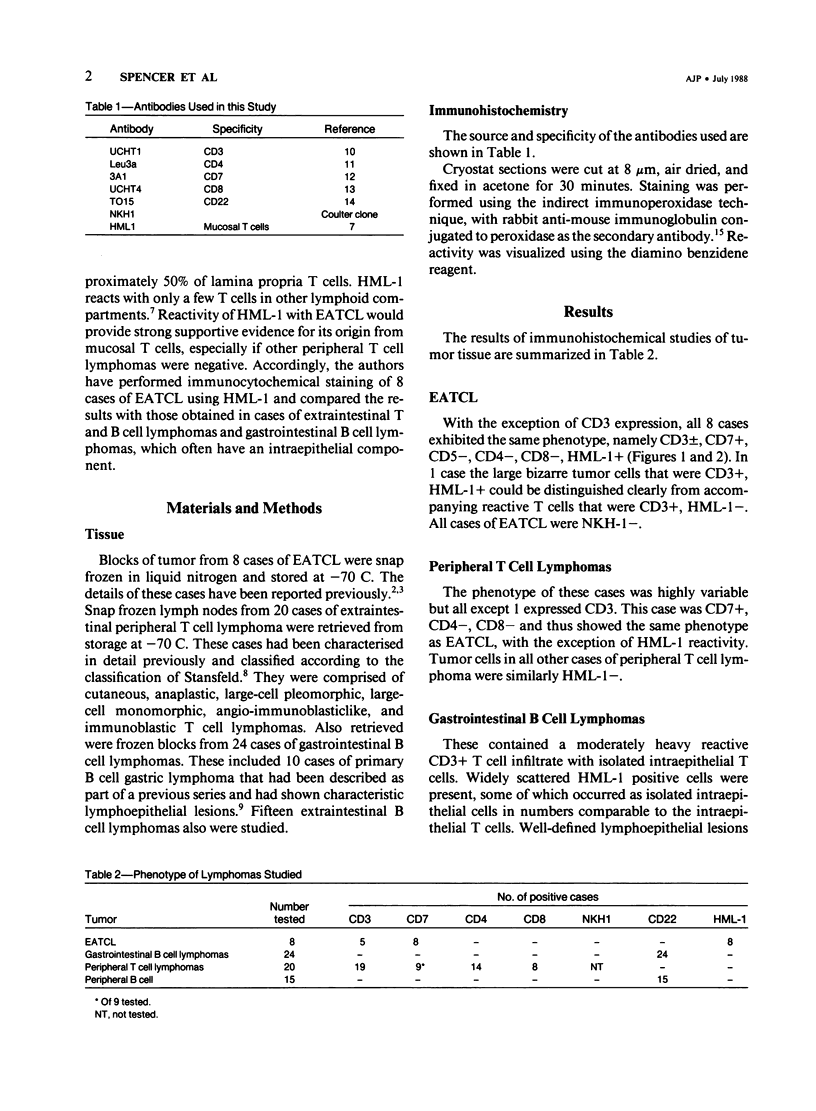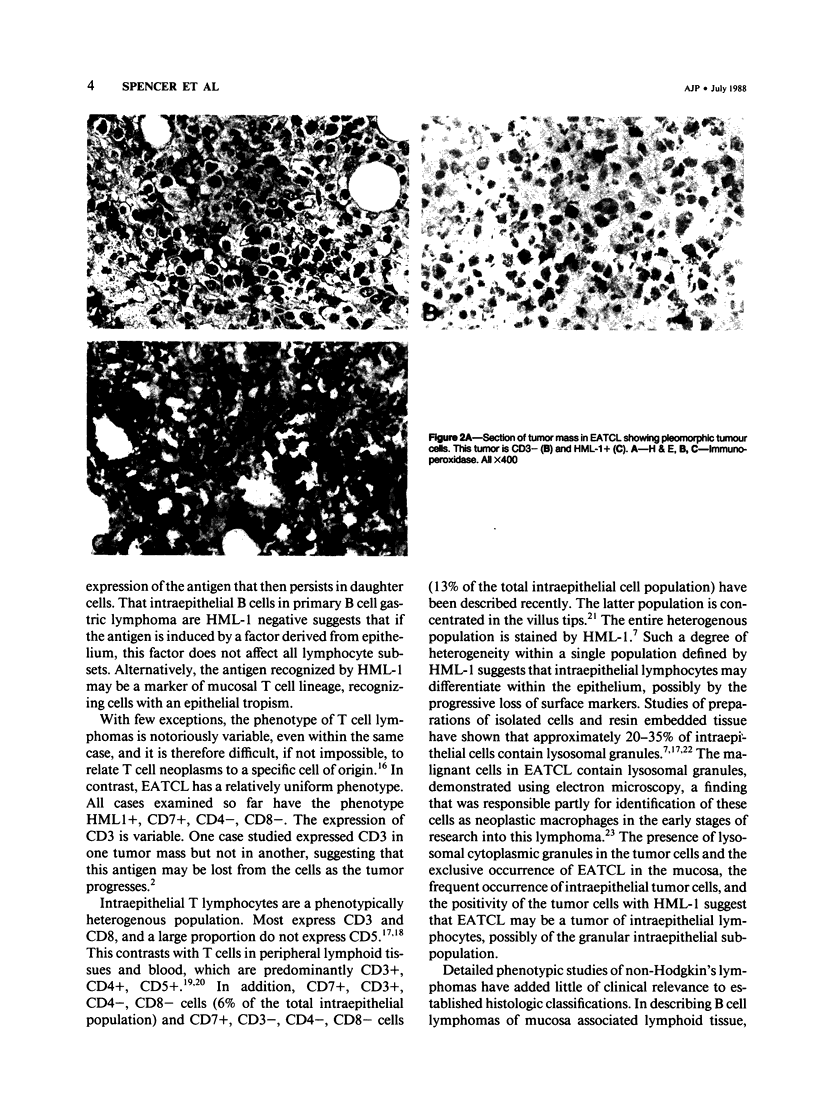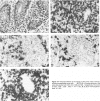Abstract
Enteropathy-associated T cell lymphoma (EATCL; malignant histiocytosis of the intestine) arises in patients with enteropathy, which in some cases is known to be a result of gluten sensitivity. The lymphoma arises in the intestine, where it may remain localized, although eventual dissemination is the rule. Intraepithelial tumour cells often are seen at the mucosal tumor margin. These features suggest that EATCL may be a tumor of intraepithelial lymphocytes. A monoclonal antibody (HML-1) has been produced recently that recognizes the entire intraepithelial lymphocyte population and 50% of lamina propria T cells but very few cells outside the mucosa. Immunocytochemistry has shown that all cases of enteropathy-associated T cell lymphoma studied are HML-1 positive and all peripheral T cell lymphomas and mucosal B cell lymphomas are HML-1 negative. This suggests strongly that EATCL is a tumor of mucosal T cells, possibly the intraepithelial T cell component.
Full text
PDF




Images in this article
Selected References
These references are in PubMed. This may not be the complete list of references from this article.
- Cerf-Bensussan N., Jarry A., Brousse N., Lisowska-Grospierre B., Guy-Grand D., Griscelli C. A monoclonal antibody (HML-1) defining a novel membrane molecule present on human intestinal lymphocytes. Eur J Immunol. 1987 Sep;17(9):1279–1285. doi: 10.1002/eji.1830170910. [DOI] [PubMed] [Google Scholar]
- Evans R. L., Wall D. W., Platsoucas C. D., Siegal F. P., Fikrig S. M., Testa C. M., Good R. A. Thymus-dependent membrane antigens in man: inhibition of cell-mediated lympholysis by monoclonal antibodies to TH2 antigen. Proc Natl Acad Sci U S A. 1981 Jan;78(1):544–548. doi: 10.1073/pnas.78.1.544. [DOI] [PMC free article] [PubMed] [Google Scholar]
- Haynes B. F., Eisenbarth G. S., Fauci A. S. Human lymphocyte antigens: production of a monoclonal antibody that defines functional thymus-derived lymphocyte subsets. Proc Natl Acad Sci U S A. 1979 Nov;76(11):5829–5833. doi: 10.1073/pnas.76.11.5829. [DOI] [PMC free article] [PubMed] [Google Scholar]
- Isaacson P. G., O'Connor N. T., Spencer J., Bevan D. H., Connolly C. E., Kirkham N., Pollock D. J., Wainscoat J. S., Stein H., Mason D. Y. Malignant histiocytosis of the intestine: a T-cell lymphoma. Lancet. 1985 Sep 28;2(8457):688–691. doi: 10.1016/s0140-6736(85)92930-7. [DOI] [PubMed] [Google Scholar]
- Isaacson P. G., Spencer J., Finn T. Primary B-cell gastric lymphoma. Hum Pathol. 1986 Jan;17(1):72–82. doi: 10.1016/s0046-8177(86)80157-5. [DOI] [PubMed] [Google Scholar]
- Isaacson P., Wright D. H. Extranodal malignant lymphoma arising from mucosa-associated lymphoid tissue. Cancer. 1984 Jun 1;53(11):2515–2524. doi: 10.1002/1097-0142(19840601)53:11<2515::aid-cncr2820531125>3.0.co;2-c. [DOI] [PubMed] [Google Scholar]
- Isaacson P., Wright D. H. Malignant histiocytosis of the intestine. Its relationship to malabsorption and ulcerative jejunitis. Hum Pathol. 1978 Nov;9(6):661–677. doi: 10.1016/s0046-8177(78)80049-5. [DOI] [PubMed] [Google Scholar]
- Martin P. J., Hansen J. A., Siadak A. W., Nowinski R. C. Monoclonal antibodies recognizing normal human T lymphocytes and malignant human B lymphocytes: a comparative study. J Immunol. 1981 Nov;127(5):1920–1923. [PubMed] [Google Scholar]
- O'Farrelly C., Feighery C., O'Briain D. S., Stevens F., Connolly C. E., McCarthy C., Weir D. G. Humoral response to wheat protein in patients with coeliac disease and enteropathy associated T cell lymphoma. Br Med J (Clin Res Ed) 1986 Oct 11;293(6552):908–910. doi: 10.1136/bmj.293.6552.908. [DOI] [PMC free article] [PubMed] [Google Scholar]
- Poppema S., Bhan A. K., Reinherz E. L., McCluskey R. T., Schlossman S. F. Distribution of T cell subsets in human lymph nodes. J Exp Med. 1981 Jan 1;153(1):30–41. doi: 10.1084/jem.153.1.30. [DOI] [PMC free article] [PubMed] [Google Scholar]
- Salter D. M., Krajewski A. S., Dewar A. E. Immunophenotype analysis of malignant histiocytosis of the intestine. J Clin Pathol. 1986 Jan;39(1):8–15. doi: 10.1136/jcp.39.1.8. [DOI] [PMC free article] [PubMed] [Google Scholar]
- Salter D. M., Krajewski A. S., Kelleher D. Histogenesis of malignant histiocytosis of the intestine. Gastroenterology. 1987 Jun;92(6):2050–2051. [PubMed] [Google Scholar]
- Selby W. S., Janossy G., Bofill M., Jewell D. P. Intestinal lymphocyte subpopulations in inflammatory bowel disease: an analysis by immunohistological and cell isolation techniques. Gut. 1984 Jan;25(1):32–40. doi: 10.1136/gut.25.1.32. [DOI] [PMC free article] [PubMed] [Google Scholar]
- Stein H., Gerdes J., Mason D. Y. The normal and malignant germinal centre. Clin Haematol. 1982 Oct;11(3):531–559. [PubMed] [Google Scholar]
- Stein H., Lennert K., Feller A. C., Mason D. Y. Immunohistological analysis of human lymphoma: correlation of histological and immunological categories. Adv Cancer Res. 1984;42:67–147. doi: 10.1016/s0065-230x(08)60456-x. [DOI] [PubMed] [Google Scholar]




